Recent Why SERVPRO Posts
Here is a Helpful Checklist for Moving
7/13/2024 (Permalink)
 Woman checking her moving list.
Woman checking her moving list.
Packing up your entire home and relocating can be extremely overwhelming. In order to make the move a smooth transition, there are a few things to check up on at your new home prior to moving in. Avoid any extra stress by checking off these five tasks for your new home.
Change the Locks
Changing the locks on all your doors is an important step to feeling safe in your new home. As kind as the previous owners may have been, it’s nice knowing there isn’t anyone out there but you that has a key to your home. It’s best to schedule this task before moving all your belongings in to avoid any time period of unsecured doors during the transition.
Deep Clean the House
Hopefully, the previous owners took care of cleaning and preparing the house when they first moved out, but there are some areas to check on just to be sure the place is in pristine condition. It’s easiest to clean the hard-to-reach places before you move in and there aren’t any objects in the way. Some areas to deep clean might include inside cupboards, the washer and dryer, fridge, oven, stove, and dishwasher.
Inspect for Mold
The last thing you need is to settle into your new home only to discover it has a mold issue. The minimum you should do is at least inspect for leaks, odors, or visible signs of mold throughout the house. However, now is the prime time to schedule a mold inspection and cleanup to detect the air quality of your home and find any hidden mold.
Check Smoke and Carbon Monoxide Detectors
Speaking of air quality, make sure to check the carbon monoxide detector and smoke alarms throughout the house. It’s a relief knowing that your home is equipped with up-to-date and working monitors for you and your family’s safety. If the house doesn’t have a carbon monoxide detector yet, then now is the perfect time to purchase and install one before moving in.
Inspect the Plumbing
Make sure that the plumbing is in mint condition before moving in rather than discovering it too late. Check for leaks and any signs of water damage, and make any appointments you need to fix leaks and issues. This will not only make things run smoother, but it will also save your water bill. While you’re at it, take a look at the water heater as well. Now is a good time to flush your water heater of sediment and check if it has a water softener as well.
There is already a long list of to-dos when it comes to moving out of your house, but many things go overlooked and forgotten when it comes to the new house. Give careful consideration to the different tasks listed to make your new major change a little easier. You will feel confident and relieved moving into your new home knowing you’ve changed the locks, deep cleaned the place, inspected for mold, checked the air and alarms, and inspected the plumbing.
Source: https://www.hewnandhammered.com/hewn/2019/10/new-home-move-in-checklist.html
We are Better Together as One Community
7/13/2024 (Permalink)
 Group of people motivating each other.
Group of people motivating each other.
Our little community may be small in size but large in impact and culture. Our small but thriving areas make living in East Tennessee possibly one of the greatest places in America to live.
One great thing about our little community is that we love big. We stand behind one another in good times and in bad. We support and encourage one another. When one part of our community is struggling or faces disaster, we come alongside them as one unit in helping restore them to their previous state.
At SERVPRO®, we are proud of our community. We are privileged to come alongside it and to serve the people that live and do business inside the county lines. We are sure that there are tons of other small towns and communities like ours, but we wouldn't trade ours for the world.
We hope that our community knows that if they face fire, water, mold, or storm damage, that we will be there fast to get them back on their feet in no time. But, the best part is, we are better together!
Still having Problems with Corona Virus?
6/29/2024 (Permalink)
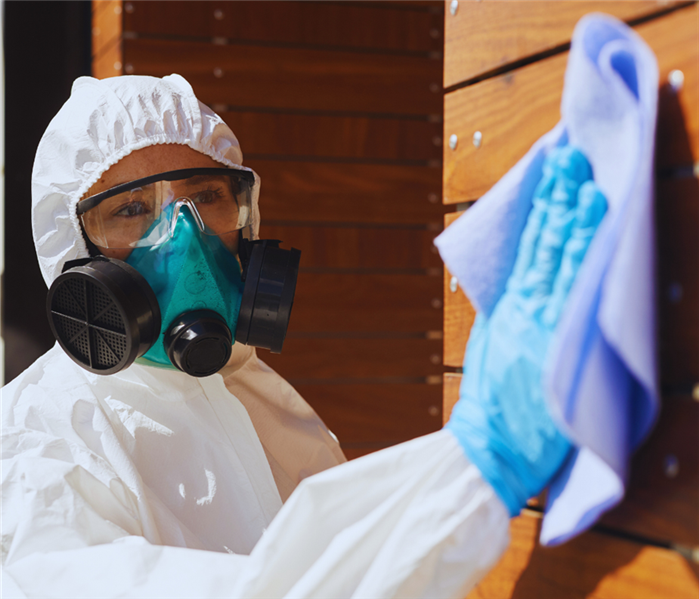 Person safely cleaning wall.
Person safely cleaning wall.
Expert Level Cleaning Services
SERVPRO® franchise professionals are uniquely prepared to clean and disinfect your home or business according to the protocols set forth by the CDC. We have years of experience in dealing with biological contaminants, and we will go beyond the scope of work that regular janitorial staff perform on a daily basis. Our professionals are trained to perform a proactive cleanup that involves facility or structure cleaning and disinfection. Cleanup procedures generally include cleaning of porous and non-porous surfaces, disinfecting of non-porous surfaces, cleaning and disinfecting of equipment, tools, and/or supplies used for cleanup process, and disposal of waste.
The CDC encourages cleaning of high-touch surfaces such as counters, tabletops, doorknobs, light switches, bathroom fixtures, toilets, phones, keyboards, tablets and tables. Other spaces mentioned in the CDC’s guidance for commercial spaces include:
- Kitchen/Food Areas
- Bathrooms
- Schools/Classrooms
- Offices
- Retail Spaces
- Water Fountains
- Shelving/Racks
- Sales Counters
- Carpets and Rugs
- Stair Handrails
- Elevator Cars
- Playground Equipment
- Fitness Equipment
Moving Check List
7/13/2023 (Permalink)
 New home awaiting its new owners!
New home awaiting its new owners!
Packing up your entire home and relocating can be extremely overwhelming. In order to make the move a smooth transition, there are a few things to check up on at your new home prior to moving in. Avoid any extra stress by checking off these five tasks for your new home.
Change the Locks
Changing the locks on all your doors is an important step to feeling safe in your new home. As kind as the previous owners may have been, it’s nice knowing there isn’t anyone out there but you that has a key to your home. It’s best to schedule this task before moving all your belongings in to avoid any time period of unsecured doors during the transition.
Deep Clean the House
Hopefully, the previous owners took care of cleaning and preparing the house when they first moved out, but there are some areas to check on just to be sure the place is in pristine condition. It’s easiest to clean the hard-to-reach places before you move in and there aren’t any objects in the way. Some areas to deep clean might include inside cupboards, the washer and dryer, fridge, oven, stove, and dishwasher.
Inspect for Mold
The last thing you need is to settle into your new home only to discover it has a mold issue. The minimum you should do is at least inspect for leaks, odors, or visible signs of mold throughout the house. However, now is the prime time to schedule a mold inspection and cleanup to detect the air quality of your home and find any hidden mold.
Check Smoke and Carbon Monoxide Detectors
Speaking of air quality, make sure to check the carbon monoxide detector and smoke alarms throughout the house. It’s a relief knowing that your home is equipped with up-to-date and working monitors for you and your family’s safety. If the house doesn’t have a carbon monoxide detector yet, then now is the perfect time to purchase and install one before moving in.
Inspect the Plumbing
Make sure that the plumbing is in mint condition before moving in rather than discovering it too late. Check for leaks and any signs of water damage, and make any appointments you need to fix leaks and issues. This will not only make things run smoother, but it will also save your water bill. While you’re at it, take a look at the water heater as well. Now is a good time to flush your water heater of sediment and check if it has a water softener as well.
There is already a long list of to-dos when it comes to moving out of your house, but many things go overlooked and forgotten when it comes to the new house. Give careful consideration to the different tasks listed to make your new major change a little easier. You will feel confident and relieved moving into your new home knowing you’ve changed the locks, deep cleaned the place, inspected for mold, checked the air and alarms, and inspected the plumbing.
Source: https://www.hewnandhammered.com/hewn/2019/10/new-home-move-in-checklist.html
As a Community, We Are Better Together
7/13/2023 (Permalink)
 The beautiful mountains of East Tennessee.
The beautiful mountains of East Tennessee.
Our little community may be small in size but large in impact and culture. Our small but thriving areas make living in East Tennessee possibly one of the greatest places in America to live.
One great thing about our little community is that we love big. We stand behind one another in good times and in bad. We support and encourage one another. When one part of our community is struggling or faces disaster, we come alongside them as one unit in helping restore them to their previous state.
At SERVPRO, we are proud of our community. We are privileged to come alongside it and to serve the people that live and do business inside the county lines. We are sure that there are tons of other small towns and communities like ours, but we wouldn't trade ours for the world.
We hope that our community knows that if they face fire, water, mold, or storm damage, that we will be there fast to get them back on their feet in no time. But, the best part is, we are better together!
Corona Virus Giving You Trouble Still?
6/29/2023 (Permalink)
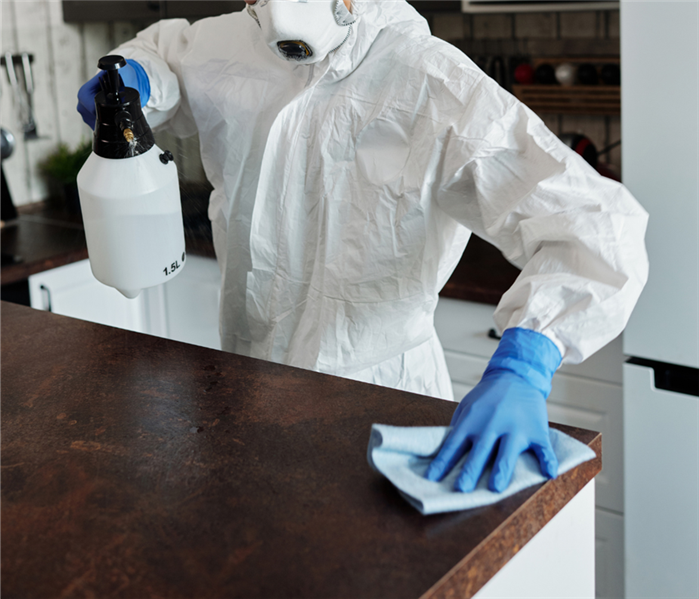 Person safely cleaning down the counter surface.
Person safely cleaning down the counter surface.
Expert Level Cleaning Services
SERVPRO® franchise professionals are uniquely prepared to clean and disinfect your home or business according to the protocols set forth by the CDC. We have years of experience in dealing with biological contaminants, and we will go beyond the scope of work that regular janitorial staff perform on a daily basis. Our professionals are trained to perform a proactive cleanup that involves facility or structure cleaning and disinfection. Cleanup procedures generally include cleaning of porous and non-porous surfaces, disinfecting of non-porous surfaces, cleaning and disinfecting of equipment, tools, and/or supplies used for cleanup process, and disposal of waste.
The CDC encourages cleaning of high-touch surfaces such as counters, tabletops, doorknobs, light switches, bathroom fixtures, toilets, phones, keyboards, tablets and tables. Other spaces mentioned in the CDC’s guidance for commercial spaces include:
- Kitchen/Food Areas
- Bathrooms
- Schools/Classrooms
- Offices
- Retail Spaces
- Water Fountains
- Shelving/Racks
- Sales Counters
- Carpets and Rugs
- Stair Handrails
- Elevator Cars
- Playground Equipment
- Fitness Equipment
Specialized Products
The CDC recommends usage of a labeled hospital-grade disinfectant with claims against similar pathogens to the coronavirus. Multiple products in the SERVPRO product line carry the EPA-approved emerging pathogens claims.
Minimize Your Risk
Tips and Best Practices to Reduce Your Risk
Cities and states took drastic measures to curb the severity of the pandemic, including the closing of bars, restaurants, and public venues. In some areas, officials issued “shelter in place” orders in order to compel residents to stay in their homes and limit movement. To protect yourself, minimize your exposure with the following tips:
Practice Good Hygiene
- Clean hands with sanitizer and wash your hands frequently
- Avoid touching your face and cover coughs and sneezes
- Disinfect “high touch” surfaces like doorknobs, light switches, tables, doorknobs, and handrails regularly
- Increase ventilation by opening windows or adjusting air conditioning
At The Office
- Stop shaking hands – use other noncontact methods of greeting
- Use videoconferencing for meetings when possible
- When not possible, hold meetings in open, well-ventilated spaces
- Disinfect “high touch” surfaces like desks, keyboards, light switches, doorknobs, and telephones
Stay Home if...
- You are feeling sick
- You have a sick family member in their home
Sources:https://www.cdc.gov/coronavirus/2019-ncov/cases-updates/summary.html?CDC_AA_refVal=https%3A%2F%2Fwww.cdc.gov%2Fcoronavirus%2F2019-ncov%2Fsummary.html
https://www.cdc.gov/coronavirus/2019-ncov/symptoms-testing/symptoms.html?CDC_AA_refVal=https%3A%2F%2Fwww.cdc.gov%2Fcoronavirus%2F2019-ncov%2Fabout%2Fsymptoms.html
https://www.SERVPRO.com/resources/specialty-cleaning/coronavirus
Experiencing a Biohazard Emergency?
12/12/2022 (Permalink)
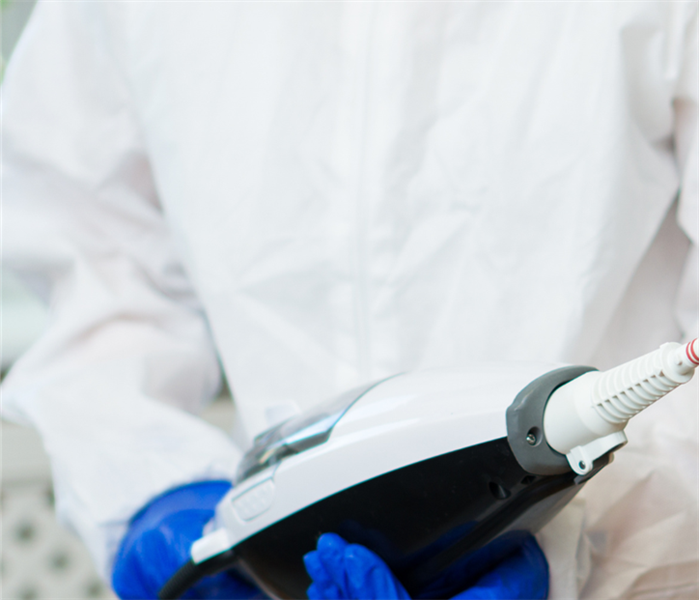 Person in a biohazard suit holding a cleaning spray device in their hands.
Person in a biohazard suit holding a cleaning spray device in their hands.
Biohazard contaminants should be considered very dangerous. Sewer backups and flood water are two common biohazard scenarios that can affect homes and businesses. SERVPRO has the training, protective gear, and specialized equipment necessary to safely clean and restores this type of contamination.
What To Do After a Contamination
- Stay out of affected areas.
- Call emergency service personnel if the situation is life-threatening.
- Treat all bodily fluids as if they are contaminated.
- Turn off the HVAC system if there is sewage damage.
What Not To Do After a Contamination
- Don’t leave wet fabrics in place. Hang furs and leather goods.
- Don’t leave books, magazines, or other colored items on wet carpet or floors.
- Don’t use your household vacuum to remove water.
- Don’t use television or other household appliances.
- Don’t turn on ceiling fixtures if the ceiling is wet, and keep out of rooms where ceilings are sagging.
24-Hour Emergency Service
Biohazards like flood water or sewer backups should be considered an emergency and dealt with as quickly as possible. SERVPRO professionals are water damage restoration specialists and have specific training and expertise to safely remediate biohazard contaminants.
(source:https://www.SERVPRO.com/resources/specialty-cleaning/biohazard-emergency-tips)
Sewage Restoration and Clean Up
12/12/2022 (Permalink)
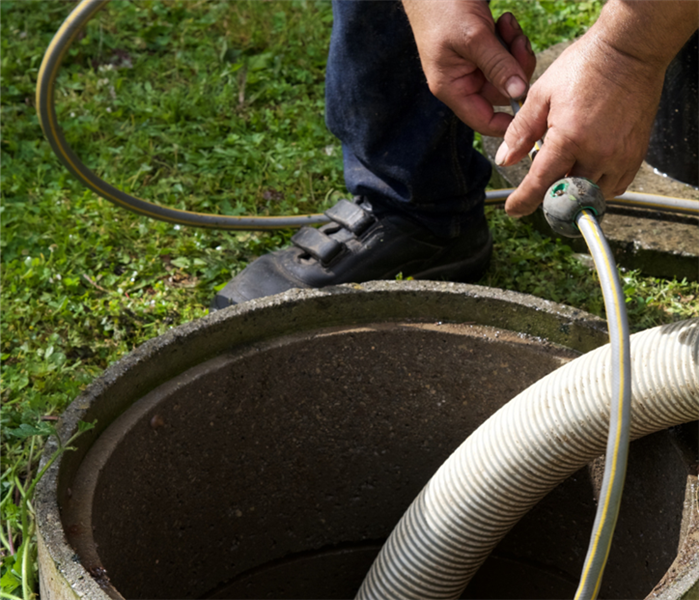 Man cleaning up Sewage.
Man cleaning up Sewage.
Sewer backups should be considered an emergency since the water may contain viruses, bacteria, and other microbes that cause serious illnesses. SERVPRO has the specialized training and equipment to quickly and safely clean contaminants like sewage.
Toilet Overflow or Sewer Backup?
Water damage can be classified by the three types of contaminated water. SERVPRO will inspect your home or business to determine the appropriate plan of action for the type of water encountered.
The three types of contaminated water:
1: Category 1 water is from a clean source like a broken water supply line or leaking faucet. If not treated quickly, this water can turn into category 2 or 3, depending on length of time, temperature, and contact with surrounding contaminants.
- Water from a clean source like a broken water line
- If left untreated, can degrade into category 2 or 3
2: Category 2 water is contaminated and could cause discomfort or illness. Examples include washing machine overflow; toilet overflow with some urine, but no feces; or dishwasher overflow.
- May contain bacteria and viruses
- Can quickly degrade into category 3 if left untreated
3: Category 3 water is grossly contaminated and could cause severe illness or death if ingested and any contact should be avoided. Examples include flooding from rivers or streams, water from beyond the toilet trap, water from the toilet bowl with feces, or standing water that has begun to support microbial growth.
- May contain untreated sewage, harsh chemicals, and microbes
- Water from flooding rivers or sewer backup
We offer 24-Hour Emergency Service
Water contaminated with sewage backup should be considered an emergency situation and dealt with as quickly as possible. A SERVPRO team near you is available 24 hours a day, 365 days a year. They are water damage restoration specialists with specialized training, equipment and protective gear to safely restore your home or business.
(source: https://www.SERVPRO.com/resources/specialty-cleaning/sewage-cleanup-and-restoration)
Coronavirus Cleaning? Yes, we also do that!
12/12/2022 (Permalink)
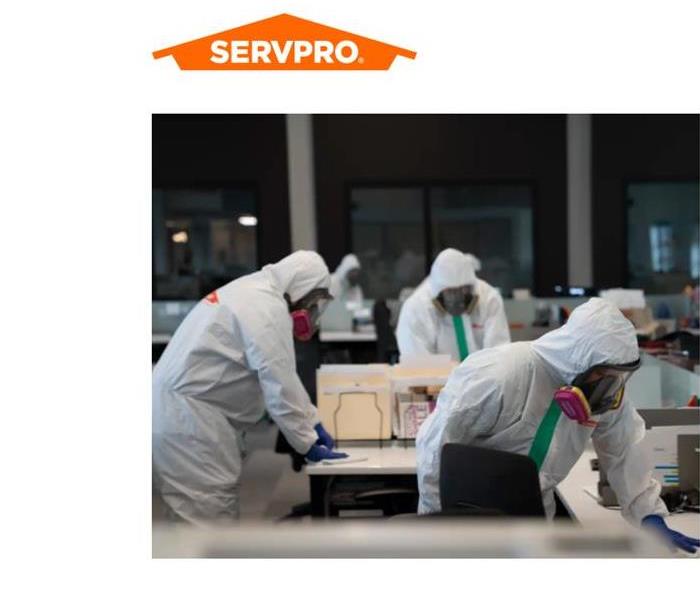 SERVPRO employees in hazmat suits cleaning.
SERVPRO employees in hazmat suits cleaning.
Here to Help® and Ready to Respond
About Coronavirus
Beginning in 2020, The Centers for Disease Control and Prevention responded to an outbreak of a respiratory disease caused by a new coronavirus that was first detected in China and spread internationally. While the virus is termed coronavirus, the sickness that results after infection is termed COVID-19.
COVID-19 was declared a pandemic, which is a global outbreak of a disease.
Expert Level Cleaning Services
SERVPRO® franchise professionals are uniquely prepared to clean and disinfect your home or business according to the protocols set forth by the CDC. We have years of experience in dealing with biological contaminants, and we will go beyond the scope of work that regular janitorial staff perform on a daily basis. Our professionals are trained to perform a proactive cleanup that involves facility or structure cleaning and disinfection. Cleanup procedures generally include cleaning of porous and non-porous surfaces, disinfecting of non-porous surfaces, cleaning and disinfecting of equipment, tools, and/or supplies used for cleanup process, and disposal of waste.
The CDC encourages cleaning of high-touch surfaces such as counters, tabletops, doorknobs, light switches, bathroom fixtures, toilets, phones, keyboards, tablets and tables. Other spaces mentioned in the CDC’s guidance for commercial spaces include:
- Kitchen/Food Areas
- Bathrooms
- Schools/Classrooms
- Offices
- Retail Spaces
- Water Fountains
- Shelving/Racks
- Sales Counters
- Carpets and Rugs
- Stair Handrails
- Elevator Cars
- Playground Equipment
- Fitness Equipment
Specialized Products
The CDC recommends the usage of a labeled hospital-grade disinfectant with claims against similar pathogens to the coronavirus. Multiple products in the SERVPRO product line carry the EPA-approved emerging pathogens claims.
Minimize Your Risk
Tips and Best Practices to Reduce Your Risk
Cities and states took drastic measures to curb the severity of the pandemic, including the closing of bars, restaurants, and public venues. In some areas, officials issued “shelter in place” orders in order to compel residents to stay in their homes and limit movement. To protect yourself, minimize your exposure with the following tips:
Practice Good Hygiene
- Clean your hands with sanitizer and wash your hands frequently
- Avoid touching your face and cover coughs and sneezes
- Disinfect “high touch” surfaces like doorknobs, light switches, tables, doorknobs, and handrails regularly
- Increase ventilation by opening windows or adjusting air conditioning
At The Office
- Stop shaking hands – use other noncontact methods of greeting
- Use videoconferencing for meetings when possible
- When not possible, hold meetings in open, well-ventilated spaces
- Disinfect “high touch” surfaces like desks, keyboards, light switches, doorknobs, and telephones
Stay Home if...
- You are feeling sick.
- You have a sick family member in their home.
Sources:https://www.cdc.gov/coronavirus/2019-ncov/cases-updates/summary.html?CDC_AA_refVal=https%3A%2F%2Fwww.cdc.gov%2Fcoronavirus%2F2019-ncov%2Fsummary.html
https://www.cdc.gov/coronavirus/2019-ncov/symptoms-testing/symptoms.html?CDC_AA_refVal=https%3A%2F%2Fwww.cdc.gov%2Fcoronavirus%2F2019-ncov%2Fabout%2Fsymptoms.html
https://www.SERVPRO.com/resources/specialty-cleaning/coronavirus
We are Better Together
7/14/2022 (Permalink)
 The beautiful mountains of East Tennessee.
The beautiful mountains of East Tennessee.
Our little community may be small in size but large in impact and culture. Our small but thriving areas make living in East Tennessee possibly one of the greatest places in America to live.
One great thing about our little community is that we love big. We stand behind one another in good times and in bad. We support and encourage one another. When one part of our community is struggling or faces disaster, we come alongside them as one unit in helping restore them to their previous state.
At SERVPRO, we are proud of our community. We are privileged to come alongside it and to serve the people that live and do business inside the county lines. We are sure that there are tons of other small towns and communities like ours, but we wouldn't trade ours for the world.
We hope that our community knows that if they face fire, water, mold, or storm damage, that we will be there fast to get them back on their feet in no time. But, the best part is, we are better together!
Check List for Moving
7/14/2022 (Permalink)
 New home awaiting its new owners!
New home awaiting its new owners!
Packing up your entire home and relocating can be extremely overwhelming. In order to make the move a smooth transition, there are a few things to check up on at your new home prior to moving in. Avoid any extra stresses by checking off these five tasks for your new home.
Change the Locks
Changing the locks on all your doors is an important step to feeling safe in your new home. As kind as the previous owners may have been, it’s nice knowing there isn’t anyone out there but you that has a key to your home. It’s best to schedule this task before moving all your belongings in to avoid any time period of unsecured doors during the transition.
Deep Clean the House
Hopefully, the previous owners took care of cleaning and preparing the house when they first moved out, but there are some areas to check on just to be sure the place is in pristine condition. It’s easiest to clean the hard-to-reach places before you move in and there aren’t any objects in the way. Some areas to deep clean might include inside cupboards, the washer and dryer, fridge, oven, stove, and dishwasher.
Inspect for Mold
The last thing you need is to settle into your new home only to discover it has a mold issue. The minimum you should do is at least inspect for leaks, odors, or visible signs of mold throughout the house. However, now is the prime time to schedule a mold inspection and cleanup to detect the air quality of your home and find any hidden mold.
Check Smoke and Carbon Monoxide Detectors
Speaking of air quality, make sure to check the carbon monoxide detector and smoke alarms throughout the house. It’s a relief knowing that your home is equipped with up-to-date and working monitors for you and your family’s safety. If the house doesn’t have a carbon monoxide detector yet, then now is the perfect time to purchase and install one before moving in.
Inspect the Plumbing
Make sure that the plumbing is in mint condition before moving in rather than discovering it too late. Check for leaks and any signs of water damage, and make any appointments you need to fix leaks and issues. This will not only make things run smoother, but it will also save your water bill. While you’re at it, take a look at the water heater as well. Now is a good time to flush your water heater of sediment and check if it has a water softener as well.
There is already a long list of to-dos when it comes to moving out of your house, but many things go overlooked and forgotten when it comes to the new house. Give careful consideration to the different tasks listed to make your new major change a little easier. You will feel confident and relieved moving into your new home knowing you’ve changed the locks, deep cleaned the place, inspected for mold, checked the air and alarms, and inspected the plumbing.
Source: https://www.hewnandhammered.com/hewn/2019/10/new-home-move-in-checklist.html
Corona Virus Still Giving You Trouble?
7/1/2022 (Permalink)
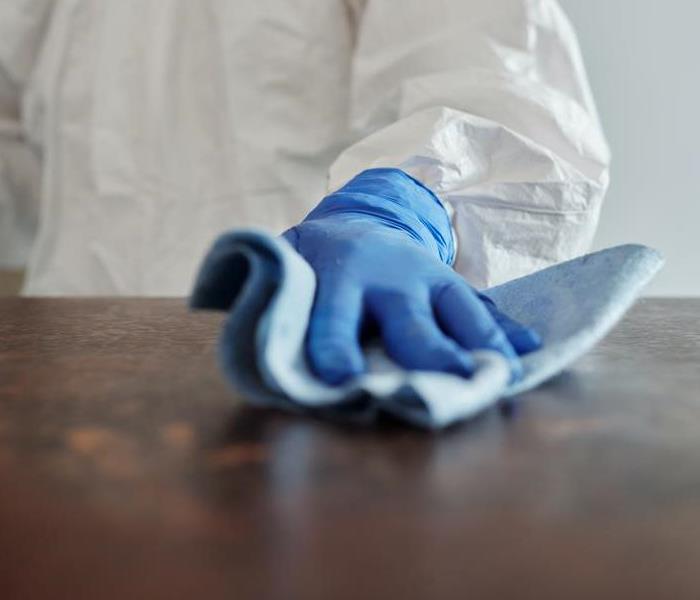 Person safely cleaning down a table surface.
Person safely cleaning down a table surface.
Expert Level Cleaning Services
SERVPRO® franchise professionals are uniquely prepared to clean and disinfect your home or business according to the protocols set forth by the CDC. We have years of experience in dealing with biological contaminants, and we will go beyond the scope of work that regular janitorial staff perform on a daily basis. Our professionals are trained to perform a proactive cleanup that involves facility or structure cleaning and disinfection. Cleanup procedures generally include cleaning of porous and non-porous surfaces, disinfecting of non-porous surfaces, cleaning and disinfecting of equipment, tools, and/or supplies used for cleanup process, and disposal of waste.
The CDC encourages cleaning of high-touch surfaces such as counters, tabletops, doorknobs, light switches, bathroom fixtures, toilets, phones, keyboards, tablets and tables. Other spaces mentioned in the CDC’s guidance for commercial spaces include:
- Kitchen/Food Areas
- Bathrooms
- Schools/Classrooms
- Offices
- Retail Spaces
- Water Fountains
- Shelving/Racks
- Sales Counters
- Carpets and Rugs
- Stair Handrails
- Elevator Cars
- Playground Equipment
- Fitness Equipment
Specialized Products
The CDC recommends usage of a labeled hospital-grade disinfectant with claims against similar pathogens to the coronavirus. Multiple products in the SERVPRO product line carry the EPA-approved emerging pathogens claims.
Minimize Your Risk
Tips and Best Practices to Reduce Your Risk
Cities and states took drastic measures to curb the severity of the pandemic, including the closing of bars, restaurants, and public venues. In some areas, officials issued “shelter in place” orders in order to compel residents to stay in their homes and limit movement. To protect yourself, minimize your exposure with the following tips:
Practice Good Hygiene
- Clean hands with sanitizer and wash your hands frequently
- Avoid touching your face and cover coughs and sneezes
- Disinfect “high touch” surfaces like doorknobs, light switches, tables, doorknobs, and handrails regularly
- Increase ventilation by opening windows or adjusting air conditioning
At The Office
- Stop shaking hands – use other noncontact methods of greeting
- Use videoconferencing for meetings when possible
- When not possible, hold meetings in open, well-ventilated spaces
- Disinfect “high touch” surfaces like desks, keyboards, light switches, doorknobs, and telephones
Stay Home if...
- You are feeling sick
- You have a sick family member in their home
Sources:https://www.cdc.gov/coronavirus/2019-ncov/cases-updates/summary.html?CDC_AA_refVal=https%3A%2F%2Fwww.cdc.gov%2Fcoronavirus%2F2019-ncov%2Fsummary.html
https://www.cdc.gov/coronavirus/2019-ncov/symptoms-testing/symptoms.html?CDC_AA_refVal=https%3A%2F%2Fwww.cdc.gov%2Fcoronavirus%2F2019-ncov%2Fabout%2Fsymptoms.html
https://www.SERVPRO.com/resources/specialty-cleaning/coronavirus
Coronavirus Cleaning? Yeah we do that!
12/12/2021 (Permalink)
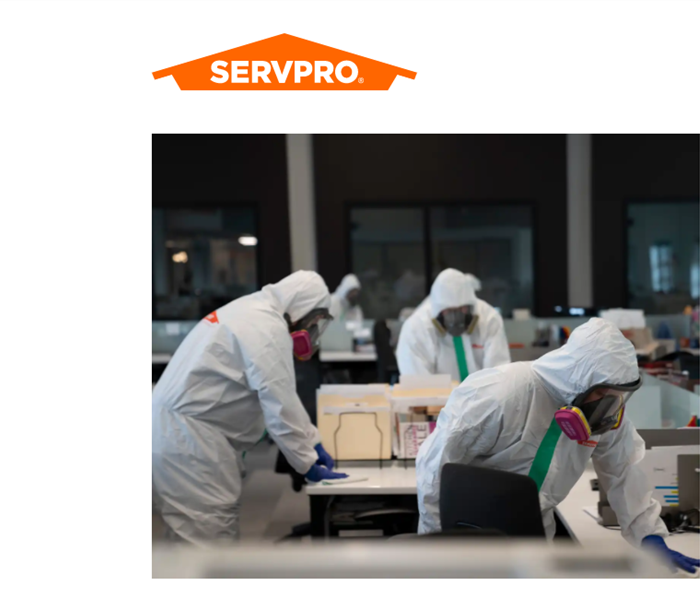 SERVPRO employees in hazmat suits cleaning.
SERVPRO employees in hazmat suits cleaning.
Here to Help® and Ready to Respond
About Coronavirus
Beginning in 2020, The Centers for Disease Control and Prevention responded to an outbreak of a respiratory disease caused by a new coronavirus that was first detected in China and spread internationally. While the virus is termed coronavirus, the sickness that results after infection is termed COVID-19.
COVID-19 was declared a pandemic, which is a global outbreak of a disease.
Expert Level Cleaning Services
SERVPRO® franchise professionals are uniquely prepared to clean and disinfect your home or business according to the protocols set forth by the CDC. We have years of experience in dealing with biological contaminants, and we will go beyond the scope of work that regular janitorial staff perform on a daily basis. Our professionals are trained to perform a proactive cleanup that involves facility or structure cleaning and disinfection. Cleanup procedures generally include cleaning of porous and non-porous surfaces, disinfecting of non-porous surfaces, cleaning and disinfecting of equipment, tools, and/or supplies used for cleanup process, and disposal of waste.
The CDC encourages cleaning of high-touch surfaces such as counters, tabletops, doorknobs, light switches, bathroom fixtures, toilets, phones, keyboards, tablets and tables. Other spaces mentioned in the CDC’s guidance for commercial spaces include:
- Kitchen/Food Areas
- Bathrooms
- Schools/Classrooms
- Offices
- Retail Spaces
- Water Fountains
- Shelving/Racks
- Sales Counters
- Carpets and Rugs
- Stair Handrails
- Elevator Cars
- Playground Equipment
- Fitness Equipment
Specialized Products
The CDC recommends usage of a labeled hospital-grade disinfectant with claims against similar pathogens to the coronavirus. Multiple products in the SERVPRO product line carry the EPA-approved emerging pathogens claims.
Minimize Your Risk
Tips and Best Practices to Reduce Your Risk
Cities and states took drastic measures to curb the severity of the pandemic, including the closing of bars, restaurants, and public venues. In some areas, officials issued “shelter in place” orders in order to compel residents to stay in their homes and limit movement. To protect yourself, minimize your exposure with the following tips:
Practice Good Hygiene
- Clean hands with sanitizer and wash your hands frequently
- Avoid touching your face and cover coughs and sneezes
- Disinfect “high touch” surfaces like doorknobs, light switches, tables, doorknobs, and handrails regularly
- Increase ventilation by opening windows or adjusting air conditioning
At The Office
- Stop shaking hands – use other noncontact methods of greeting
- Use videoconferencing for meetings when possible
- When not possible, hold meetings in open, well-ventilated spaces
- Disinfect “high touch” surfaces like desks, keyboards, light switches, doorknobs, and telephones
Stay Home if...
- You are feeling sick
- You have a sick family member in their home
Sources:https://www.cdc.gov/coronavirus/2019-ncov/cases-updates/summary.html?CDC_AA_refVal=https%3A%2F%2Fwww.cdc.gov%2Fcoronavirus%2F2019-ncov%2Fsummary.html
https://www.cdc.gov/coronavirus/2019-ncov/symptoms-testing/symptoms.html?CDC_AA_refVal=https%3A%2F%2Fwww.cdc.gov%2Fcoronavirus%2F2019-ncov%2Fabout%2Fsymptoms.html
https://www.SERVPRO.com/resources/specialty-cleaning/coronavirus
Restoration and Cleaning up Sewage
12/12/2021 (Permalink)
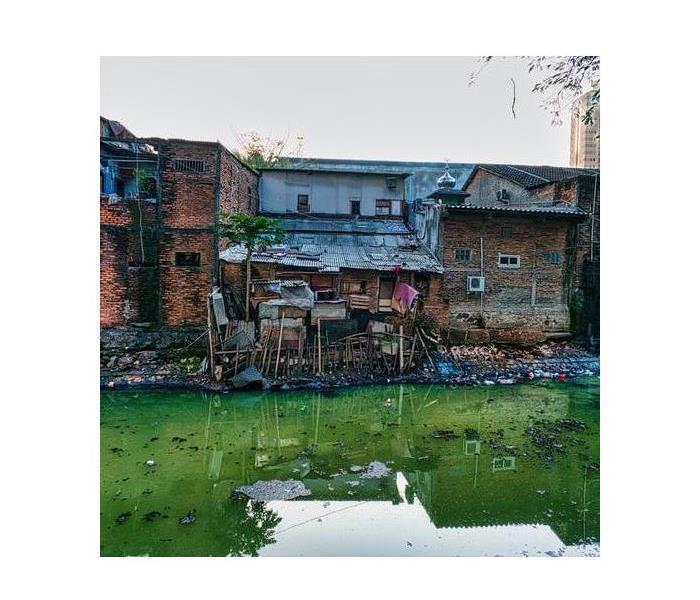 Sewage overflowing into yard and house.
Sewage overflowing into yard and house.
Sewer backups should be considered an emergency since the water may contain viruses, bacteria, and other microbes that cause serious illnesses. SERVPRO has the specialized training and equipment to quickly and safely clean contaminants like sewage.
Toilet Overflow or Sewer Backup?
Water damage can be classified by the three types of contaminated water. SERVPRO will inspect your home or business to determine the appropriate plan of action for the type of water encountered.
The three types of contaminated water:
1:
Category 1 water is from a clean source like a broken water supply line or leaking faucet. If not treated quickly, this water can turn into category 2 or 3, depending on length of time, temperature, and contact with surrounding contaminants.
- Water from a clean source like a broken water line
- If left untreated, can degrade into category 2 or 3
2:
Category 2 water is contaminated and could cause discomfort or illness. Examples include washing machine overflow; toilet overflow with some urine, but no feces; or dishwasher overflow.
- May contain bacteria and viruses
- Can quickly degrade into category 3 if left untreated
3:
Category 3 water is grossly contaminated and could cause severe illness or death if ingested and any contact should be avoided. Examples include flooding from rivers or streams, water from beyond the toilet trap, water from the toilet bowl with feces, or standing water that has begun to support microbial growth.
- May contain untreated sewage, harsh chemicals, and microbes
- Water from flooding rivers or sewer backup
We offer 24-Hour Emergency Service
Water contaminated with sewage backup should be considered an emergency situation and dealt with as quickly as possible. A SERVPRO team near you is available 24 hours a day, 365 days a year. They are water damage restoration specialists with specialized training, equipment and protective gear to safely restore your home or business.
(source: https://www.SERVPRO.com/resources/specialty-cleaning/sewage-cleanup-and-restoration)
Have a Biohazard Emergency?
12/12/2021 (Permalink)
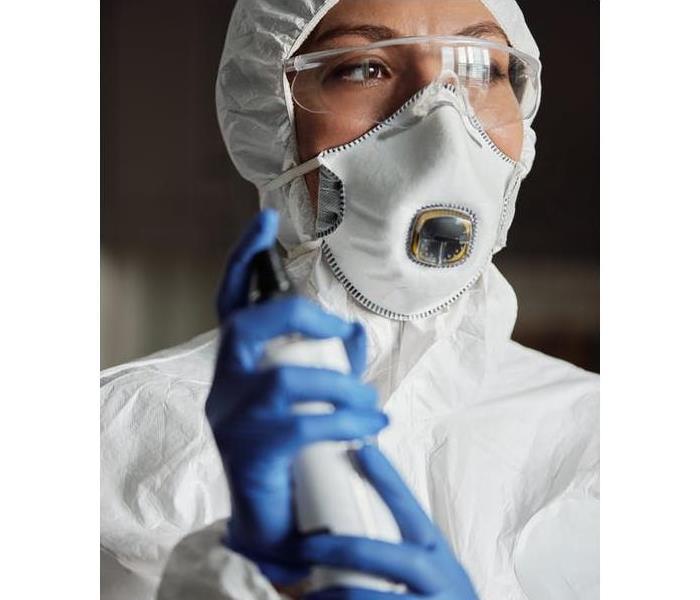 Lady in biohazard suit with cleaner in her hands.
Lady in biohazard suit with cleaner in her hands.
Biohazard contaminants should be considered very dangerous. Sewer backups and flood water are two common biohazard scenarios that can affect homes and businesses. SERVPRO has the training, protective gear, and specialized equipment necessary to safely clean and restore this type of contamination.
What To Do After a Contamination
- Stay out of affected areas.
- Call emergency service personnel if the situation is life-threatening.
- Treat all bodily fluids as if they are contaminated.
- Turn off the HVAC system if there is sewage damage.
What Not To Do After a Contamination
- Don’t leave wet fabrics in place. Hang furs and leather goods.
- Don’t leave books, magazines, or other colored items on wet carpet or floors.
- Don’t use your household vacuum to remove water.
- Don’t use television or other household appliances.
- Don’t turn on ceiling fixtures if ceiling is wet, and keep out of rooms where ceilings are sagging.
24-Hour Emergency Service
Biohazards like flood water or sewer backups should be considered an emergency and dealt with as quickly as possible. SERVPRO professionals are water damage restoration specialists and have specific training and expertise to safely remediate biohazard contaminants.
(source:https://www.SERVPRO.com/resources/specialty-cleaning/biohazard-emergency-tips)
Disaster Recovery
6/15/2021 (Permalink)
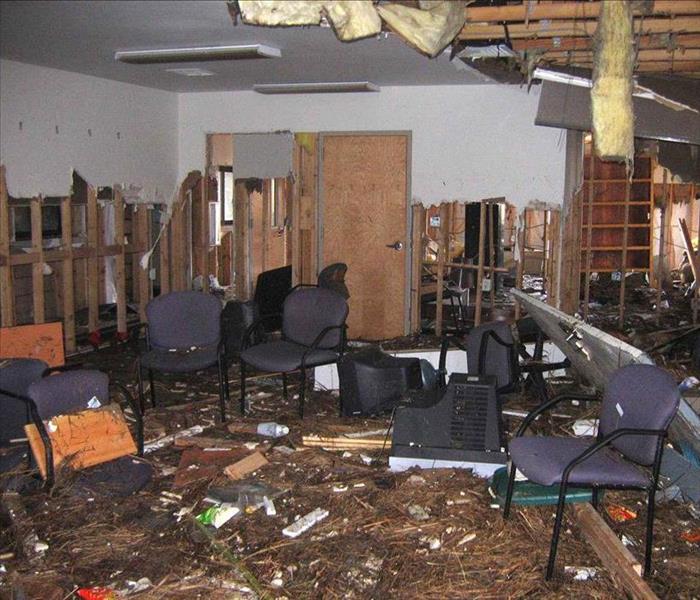 What a office looks like after a disaster.
What a office looks like after a disaster.
When we think about computers we think about data, when we think about data, we think about disaster recovery. Or at least most businesses do in this post pandemic world we live in. How often do we think about the after math and what that looks like?
Here is what that looks like:
No matter the cause of the disaster. It could be electrical, mechanical, water, and all sorts of other causes of the disaster and it would still look the same.
People going in and people coming out. All loading trucks with lots and lots of equipment that was ruined. Servers, office equipment, racks, mounts, phones, TVs, conference system, monitors, cables, security cameras, dvrs, so forth and so on. Maybe smoke, maybe water pouring out of it. Still what is certain is non of can stay.
So what do you do. You call SERVPRO. Why? Because we offer a disaster recovery team. Your gonna need that, along with all the other things you will need that goes right along with it.
Lucky for you, we specialize in:
- Commercial Water Damage Restoration
- Commercial Fire Damage Restoration
- Commercial Mold Remediation
- Commercial Storm and Major Events
- Disaster Recovery Team
You can rest assured that SERVPRO is here not only to help, but to rescue you from what can and will arise during this devastating moment of disaster striking. So the next time you need us, don't hesitate to call us or send us a message. Big or small, we got this.
Tips To Prepare Your Pipes For Winter
11/1/2019 (Permalink)
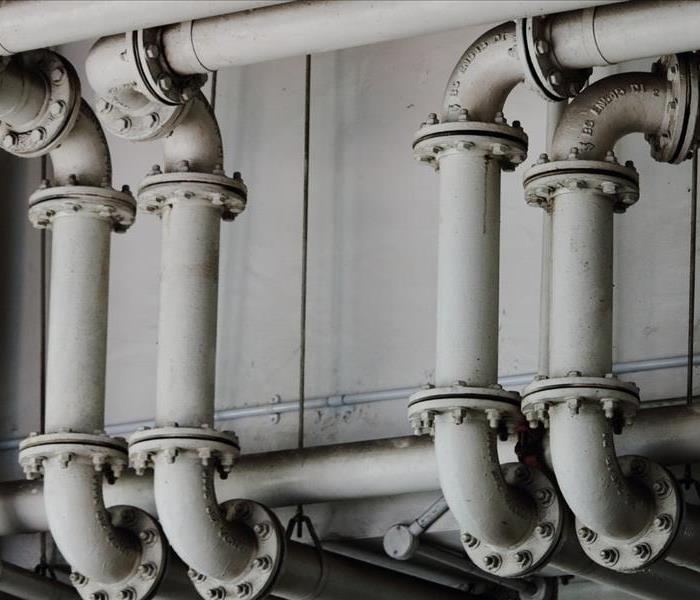 Prepare your pipes for winter.
Prepare your pipes for winter.
Have you prepared your plumbing for winter? Damage caused from burst pipes can cost you thousands, of dollars. Not all damage is covered by homeowner’s insurance. We want to make sure you know some simple steps to get you prepared. Follow these 7 simple steps to get off to a great start. Find yourself in a bind? Brogdon Plumbing is here to help! Give us a call.
- Prepare your outdoor faucets. Remove and drain your water hoses and store them indoors before the first freeze.
- Fix leaks now. Inspect your pipes and have any/all leaks repaired.
- Wrap any pipes in unheated areas of the home. This is crucial, for mobile homes. Visit the hardware store and grab some heat tape and/or pipe insulation. There are also easy to install kits, that include a thermostat. These kits can help you in the event of frigid temps for long periods. Don’t hesitate to ask an employee for recommendations. Protecting the pipes in your home, from low temperatures is THE single most important thing that you can do.
- Tune up your water heater. You will want to drain and maintain your water heater at this time every year.
- Service your furnace. Make sure you have clean filters and call a professional to help.
- Selling your home or heading south for winter? Shut off the water, in your home, completely and consider draining your pipes. Any water left in your pipes is at risk of freezing and causing pipes to bust. If nobody is home, the damage can be widespread and severe. Don’t take chances.
- Call SERVPRO at 423-745-4165.
http://www.brogdonplumbing.com/prepare-plumbing-for-winter/
Stop A Leaking Toilet Quick
11/1/2019 (Permalink)
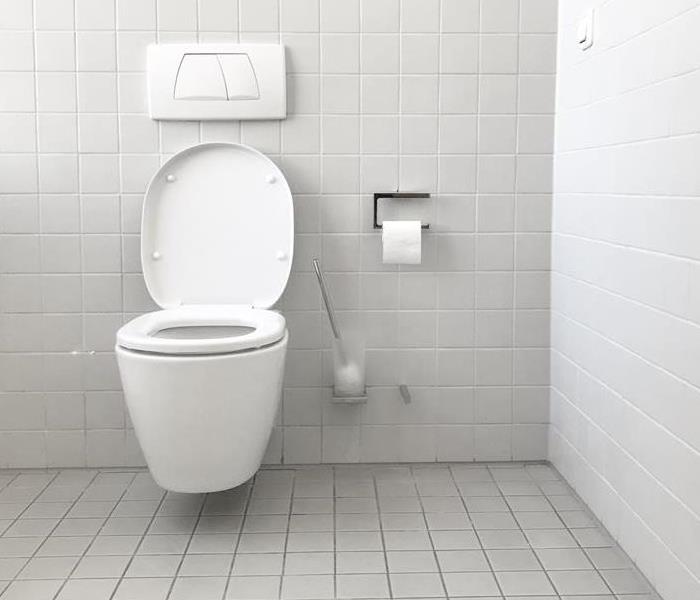 Stop a leaking toilet quick!
Stop a leaking toilet quick!
Got a leaky toilet? Believe it or not, it’s a common problem. Continue reading to find out the likeliest causes and the easiest ways to remedy the situation.
First, some of the washers between the bowl and tank may have failed. Shut off the supply valve, empty the tank with a flush, then remove the nuts, bolts, and washers from the underside of the tank. Lift the tank, position it on its side, and see if the washers need replacing.
Another culprit may be faulty fasteners securing the fill valve and ballcock to the bottom of the tank. Before you replace those parts, however, first try simply tightening the nuts and bolts holding them in place—that often solves the problem.
On the other hand, if the leak seems to be coming from the base of the tank, chances are the wax ring that seals the toilet to the floor has failed. Replacing the wax ring is a much bigger job, since it involves removing the entire toilet from its base. If you decide to replace the wax ring yourself—preferably with a friend to help with the lifting—take the extra step of also replacing any bolts that show signs of corrosion. And, once you have the toilet back in place, don’t forget to add a bead of caulk around the base.
Source: https://www.bobvila.com/articles/toilet-leaking/#.Wnxo75M-e35
Keep Heating Costs Low This Winter
11/1/2019 (Permalink)
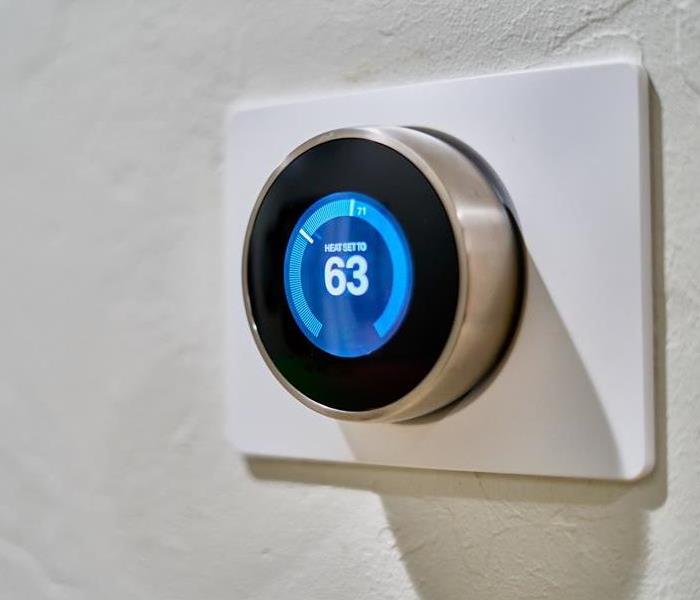 Keep your heating bill lower this winter with these easy tricks!
Keep your heating bill lower this winter with these easy tricks!
According to the U.S. Department of Energy, the average U.S. family spends at least $2,200 a year on energy bills – with nearly half of that going towards heating and cooling.
And as the temperature begins to fall, the cost to heat our homes starts to rise.
Now’s the time to make sure your home is well-insulated. A properly insulated home will keep the warmth inside, reducing your heating costs and improving comfort.
Use the five tips for insulating your home below to save on energy bills and keep you and your family nice and cozy this winter.
1. Seal Gaps Around Doors
Doors that aren’t correctly fitted to the frame form gaps. One of the simplest ways to insulate your home is to seal the gaps, typically found at the bottom of the door. These can easily be fixed by:
- Using weather strips: Weather strips are an easy, inexpensive way to stop air leaks.
- Installing draft stoppers: Also known as a door snake or door pillow, draft stoppers sit beneath the bottom of your door and can be made out of socks.
2. Cover or Repair Windows
Another tip for insulating your home is to cover or repair windows that are letting cold air in. For a quick fix, tape clear plastic film to the inside of your window frames and seal tightly. For a more long-term solution, replace old windows with new ones. Older homes that have single-pane windows lack proper insulation, causing your energy bills to skyrocket. To save money and keep those drafts from coming in, consider replacing with double or triple-pane windows.
3. Use Your Curtains
Curtains provide us with a sense of privacy, but they’re also good for insulating homes, especially if you have drafty windows. When the sun is out, open your curtains to let heat and light in. When it’s dark, close your curtains for an extra layer of insulation.
4. Insulate Your Attic
Proper insulation is not only key to finishing your attic, but increasing your energy savings as well. And when it comes to heat, about 25 percent is lost through the roof. You can reduce this by insulating the ceiling and walls. Loose-fill or batt insulation is typically installed in attics, but according to the U.S. Department of Energy, loose-fill insulation is best because it provides better coverage when properly installed.
5. Close Your Fireplace Damper
Fireplaces are a great source of heat, until they’re not. Unless a fire is burning, make sure you close your fire damper. An open damper is like leaving a window open, and if your damper is open, you’re letting heat escape. If you have installed gas logs in your fireplace, however, leave the damper open. Gas fireplaces release large amounts of carbon monoxide and therefore must always have an open damper. If your pilot light is not lit, close the damper to ensure you’re not losing any heat, but be sure to open it back up when your gas fireplace is in use.
Source: https://www.budgetdumpster.com/blog/insulate-home-cut-heating-costs/
Moving Checklist
10/29/2019 (Permalink)
 New home awaiting its new owners!
New home awaiting its new owners!
Packing up your entire home and relocating can be extremely overwhelming. In order to make the move a smooth transition, there are a few things to check up on at your new home prior to moving in. Avoid any extra stresses by checking off these five tasks for your new home.
Change the Locks
Changing the locks on all your doors is an important step to feeling safe in your new home. As kind as the previous owners may have been, it’s nice knowing there isn’t anyone out there but you that has a key to your home. It’s best to schedule this task before moving all your belongings in to avoid any time period of unsecured doors during the transition.
Deep Clean the House
Hopefully, the previous owners took care of cleaning and preparing the house when they first moved out, but there are some areas to check on just to be sure the place is in pristine condition. It’s easiest to clean the hard-to-reach places before you move in and there aren’t any objects in the way. Some areas to deep clean might include inside cupboards, the washer and dryer, fridge, oven, stove, and dishwasher.
Inspect for Mold
The last thing you need is to settle into your new home only to discover it has a mold issue. The minimum you should do is at least inspect for leaks, odors, or visible signs of mold throughout the house. However, now is the prime time to schedule a mold inspection and cleanup to detect the air quality of your home and find any hidden mold.
Check Smoke and Carbon Monoxide Detectors
Speaking of air quality, make sure to check the carbon monoxide detector and smoke alarms throughout the house. It’s a relief knowing that your home is equipped with up-to-date and working monitors for you and your family’s safety. If the house doesn’t have a carbon monoxide detector yet, then now is the perfect time to purchase and install one before moving in.
Inspect the Plumbing
Make sure that the plumbing is in mint condition before moving in rather than discovering it too late. Check for leaks and any signs of water damage, and make any appointments you need to fix leaks and issues. This will not only make things run smoother, but it will also save your water bill. While you’re at it, take a look at the water heater as well. Now is a good time to flush your water heater of sediment and check if it has a water softener as well.
There is already a long list of to-dos when it comes to moving out of your house, but many things go overlooked and forgotten when it comes to the new house. Give careful consideration to the different tasks listed to make your new major change a little easier. You will feel confident and relieved moving into your new home knowing you’ve changed the locks, deep cleaned the place, inspected for mold, checked the air and alarms, and inspected the plumbing.
Source: https://www.hewnandhammered.com/hewn/2019/10/new-home-move-in-checklist.html
We Enjoy Serving Our Community
10/17/2019 (Permalink)
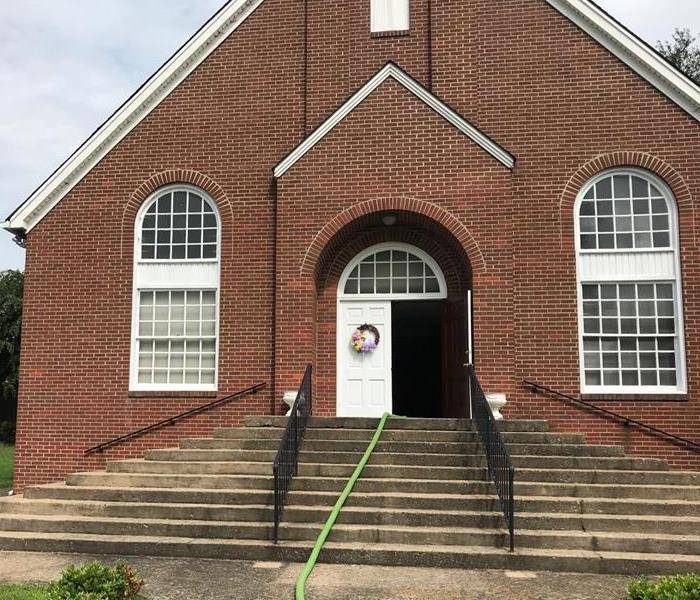 First baptist church faces water damage and SERVPRO comes to the rescue!
First baptist church faces water damage and SERVPRO comes to the rescue!
Recently, a local baptist church faced some water damage issues due to a leaky pipe inside their first floor restrooms. The leak was unnoticed until a few days after the problem arose, and the members were overwhelmed with where to start in the restoration process.
They called us at SERVPRO after they realized the problem, and we were able to be there quickly and were able to remedy the water damage and to prevent future mold growth.
We enjoy serving our community residents, businesses, and non-profits. Together, we all make our community strong and what it is today. We are privileged to serve our community in any way possible.
Together We Are Better
10/10/2019 (Permalink)
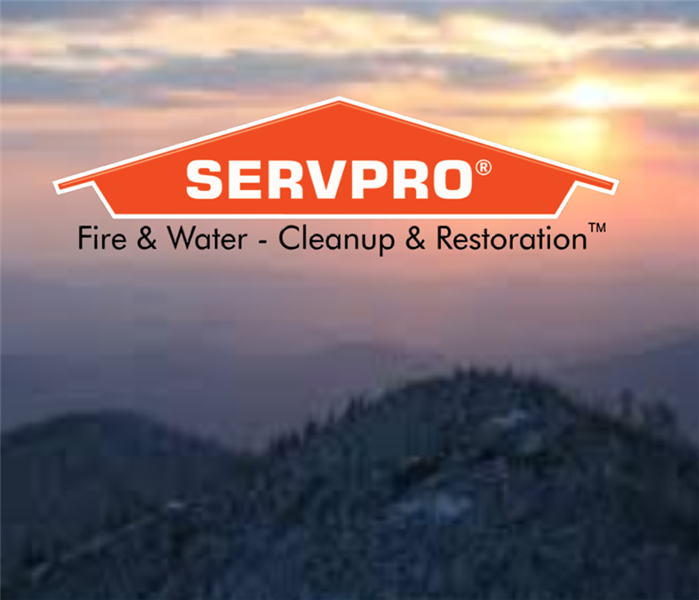 The beautiful mountains of East Tennessee.
The beautiful mountains of East Tennessee.
Our little community may be small in size but large in impact and culture. Our small but thriving areas make living in East Tennessee possibly one of the greatest places in America to live.
One great thing about our little community is that we love big. We stand behind one another in good times and in bad. We support and encourage one another. When one part of our community is struggling or faces disaster, we come alongside them as one unit in helping restore them to their previous state.
At SERVPRO, we are proud of our community. We are privileged to come alongside it and to serve the people that live and do business inside the county lines. We are sure that there are tons of other small towns and communities like ours, but we wouldn't trade ours for the world.
We hope that our community knows that if they face fire, water, mold, or storm damage, that we will be there fast to get them back on their feet in no time. But, the best part is, we are better together!



 24/7 Emergency Service
24/7 Emergency Service




















